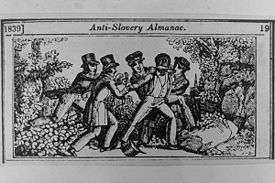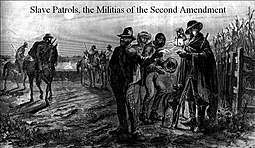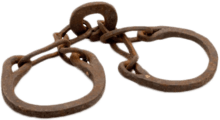Slave patrol
Slave patrols called patrollers, patterrollers, pattyrollers or paddy rollers,[1] by enslaved persons of African descent, were organized groups of armed white men who monitored and enforced discipline upon black slaves in the antebellum U.S. southern states. The slave patrols' function was to police enslaved persons, especially those who escaped or were viewed as defiant. They also formed river patrols to prevent escape by boat. Slave patrols were first established in South Carolina in 1704, and the idea spread throughout the colonies.
 A woodcut from the abolitionist Anti-Slavery Almanac (1839) depicts the capture of a fugitive slave by a slave patrol. | |
| Occupation | |
|---|---|
| Names | patrollers, patterrollers, pattyrollers, paddy rollers (names used by slaves for the slave patrols) |
Occupation type | law enforcement, military (1704-1877) |
Activity sectors | U.S. southern states |
| Description | |
| Competencies | policing, soldiering, detecting, tracking, marksmanship, horsemanship, boatmanship |
Related jobs | slave catcher |
Formation of slave patrols
Slave patrols first began in South Carolina in 1704 and spread throughout the thirteen colonies, lasting well beyond the American Revolution. As the population of enslaved black people boomed, especially with the invention of the cotton gin, so did the fear of resistance and uprisings by the enslaved. The development of slave patrols began when other means of slave control failed to quell enslaved people's resistance. Their biggest concern were the enslaved being held against their will on the plantations since that is where enslaved populations were highest. Initially, incentives were offered to whites such as tobacco and money to urge whites to be more vigilant in the capture of enslaved persons that escaped (runaway). When this approach failed, slave patrols were formally established.[2] Laws were put into place to regulate the activities of both blacks and whites. Slaves who were encountered without passes from a white person, typically a so-called master, were expected to be returned to their owners, as stated in the slave code. Punishment for runaway slaves could be expected. Black persons were subjected to questioning, searches, and other forms of harassment. Oftentimes, whippings and beatings could be expected. More than floggings and beatings, however, enslaved people feared the threat of being placed on the auction block and being separated from their families. If caught by patrols and returned to their masters, being placed on the auction block was an option for masters who no longer wanted to deal with their "non-compliant" slaves.[3] During these times, slaves were often neglected and mistreated despite having permission to travel.
State militias as patrollers

Slave owners feared gatherings held by enslaved people would allow them to trade or steal goods, and had the potential for organizing a revolt or rebellion. South Carolina and Virginia selected patrols from state militias. State militia groups were also organized from among the cadets of the Southern military academies, of The Citadel and the Virginia Military Institute, which were founded to provide a military command structure and discipline within the slave patrols and to detect, encounter, and crush any organized slave meetings that might lead to revolt or rebellion.[4]
Slave codes and fugitive slave laws
The Fugitive Slave Laws helped enforce the necessity for slave patrols to abide by the law. Although these laws were initially created to keep tensions low between the north and the south, it caused the physical formation of slave patrols.[5] During the Civil War, the theory of Contraband prevented the return of Southern slaves who reached Union-held territory. This helped limit the role of slave patrols/catchers and changed the war. Another form of help for slaves was the Underground Railroad, which aided slaves in their escape to Northern states. Outside of the Underground Railroad, enslaved black people went further south to ensure their freedom. Black people also formed their own organized networks and means of escape from slavery to Florida, where Black people negotiated with Native Americans and the Spanish government, and were able to live self-determined and free lives. Formerly enslaved people formed their own towns, military, and merged with the Florida population as Seminoles. Formerly imprisoned Europeans, Irish immigrants, and other former institutionalized Europeans were immigrated through race-based policies to found the state of Georgia. They were partially recruited to form a buffer state to stop enslaved Black people from escaping from the Carolinas, Georgia, and Virginia to Florida. Slave patrols in Georgia were formed for this purpose. Free Black cities and armed and trained black militaries in Florida were a direct challenge to white dominance and profits in slave-owning states. The concept of self-determined freedom was also a direct challenge to the concept that whites should rule and to the institution of slavery. Slave patrols and plantation police were organized by whites as legal and extra-legal means to stop this from occurring.
The use and physical formation of slave patrols came to its end in 1865 when the Civil War ended. This end, however, is linked to post-Civil War groups such as the Ku Klux Klan, which continued to terrorize and threaten the black community.[6] In South Carolina, colonists began to write laws that constricted slaves long before slave patrols were alive and well. Laws implemented set in motion curfews for slaves, strengthening their militia, preventing slaves from bartering goods, and establishing the Charleston town watch. These are examples of some of the laws and ideas that molded what we know as slave codes. Slave codes were different from state to state. Slave masters negotiated slave codes with their slaves.[6]
Patrollers' duties
Slave patrollers had their own characteristics, duties, and benefits, apart from slave owners and overseers. Patrollers were often equipped with guns and whips and would exert force in order to bring slaves back to their owners.
At times, blacks developed many methods of challenging slave patrolling, occasionally fighting back violently. The American Civil War developed more opportunities for resistance against slave patrols and made it easier for enslaved people to escape. Slave patrol duties started as breaking up slave meetings. These slave meetings occurred on holidays, in which they would plan revolts and uprisings. Eventually, slave patrols expanded to be year-round, not just on holidays. Slowly, new duties and rights of patrollers became permitted, including: "apprehending runaways, monitoring the rigid pass requirements for blacks traversing the countryside, breaking up large gatherings and assemblies of blacks, visiting and searching slave quarters randomly, inflicting impromptu punishments, and as occasion arose, suppressing insurrections."[6]
Slave patrols consisted mostly of white citizens. Most people in slave patrols came from working and middle-class conditions. In some southern states, the militia and army served as slave patrols. In other southern states, slave patrols came about from colonial or state government legislation. Slave patrols typically rode on horseback in groups of four or five, sometimes even in family groups. They often worked sun-up to sun-down and varied their times and locations of patrol, to lower the chances of slaves escaping. They used no special equipment. Their chief tools, instead, were whips and intimidation.
Some states, such as South Carolina, required every white man, under consequence of forty shillings, to arrest and chastise any slave found away from their home without proper verification. After slaves were arrested and chastised, they were returned to their masters. In some instances, white men encouraged slaves to escape for the sake of being rewarded after the slave had been caught and returned to their master. In some areas, killing a slave was not considered a crime by the courts or community.
Slave patrollers were compensated in several ways, including exemption from public, county, and parish taxes and fees during their term of service. In addition, some patrollers were paid additional sums with surplus money.
Also, regardless of the power patrollers held, they had limitations. For example, although whippings and beatings were permitted, a deterrent also existed. This was the fact that, if whipped or beaten too severely, the slave was then of no use to their masters as laborers the next day. As a consequence, overly-brutal patrollers could expect revenge from slave owners.[2]
Diminishing use of slave patrols
American Civil War
The Civil War, which lasted four years, directly threatened the very existence of slavery and, in turn, slave patrols. The first year after the Civil War began, slave patrols increased. Whites were expecting slave revolts, which inspired whites to appoint more patrols. As the war dragged on, more and more white men were being called upon to serve in the Confederate army. White men who would have served in slave patrols had they remained in their communities, went to serve in the Confederate army. Some young men who were turned away by the army, mostly for medical reasons, ended up taking places within the slave patrols. As slave owners entered the Confederate army, some slaves lost the shield they once had to protect them from the harsh and brutal beatings.[6]
After the Emancipation Proclamation, the increasing number of white men being called to the militias of the South in 1862 and 1863 resulted in many slave patrols simply not having enough men to be as active as they once were. As the Union army moved into local areas and communities, the likelihood that enslaved people that could flee to the areas controlled by the Union increased. Enslaved people who were considered obedient started to disappear in the night, running toward the Union army to emancipate themselves.[6]
Reconstruction
With the war lost, Southern whites' fears of African Americans increased in 1865 due to Reconstruction governments that were perceived as oppressive to the South. Even though slavery and patrols were legally ended, the patrol system still survived. Almost immediately in the aftermath of the war, informal patrols sprang into action. Later, city and rural police squads, along with the help of Union army officers, revived patrolling practices among free men. During the post-Civil War Reconstruction period of 1865–1877, old-style patrol methods resurfaced and were enforced by postwar Southern police officers and also by organizations such as the Ku Klux Klan.[6]
See also
References
- Verner D. Mitchell, Cynthia Davis (2019). Encyclopedia of the Black Arts Movement. p. 323. Rowman & Littlefield
- Bellesiles, Michael. Lethal Imagination: Violence and Brutality in American History. NYU Press; Edition Unstated edition (March 1, 1999). Print.
- Douglass, Frederick. Narrative of the Life of Frederick Douglass. Dover Publications, 1995. Print.
- Loewen, James W. Lies Across America: What Our Historic Sites Get Wrong. The New Press, 2013. Print.
- Campbell, Stanley W. (1970). The Slave Catchers: Enforcement of the Fugitive Slave Law, 1850–1860. Chapel Hill: University of North Carolina Press.
- Hadden, Sally E. (2001). Slave Patrols: Law and Violence in Virginia and the Carolinas. Harvard Historical Studies. Cambridge, MA: Harvard University Press. p. 340. ISBN 9780674012349.
Further reading
- Hummel, Jeffrey Rogers (July 2002), "Slave Patrols: Law and Violence in Virginia and the Carolinas", Economic History Association, retrieved 2 June 2020
- Time Warner Unchained Memories: Readings From the Slave Narratives
